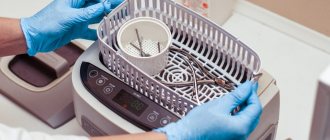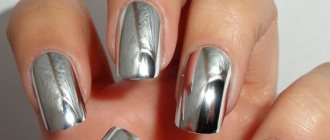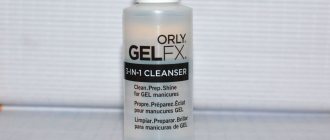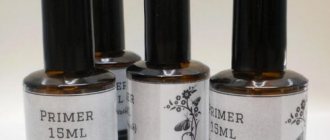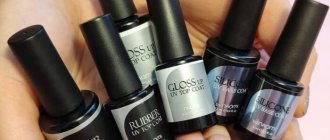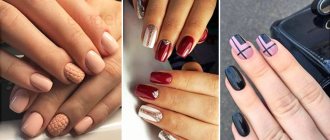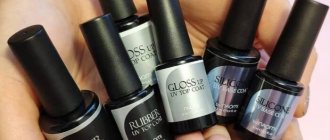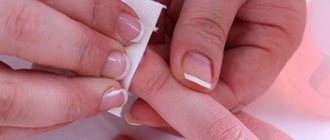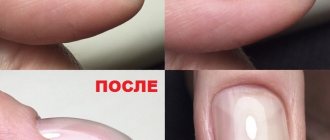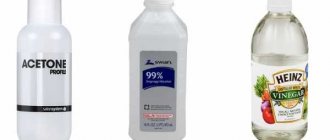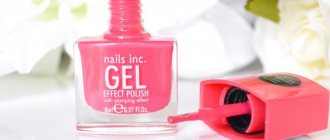Basic requirements for the adhesive composition
Nail glue is a translucent viscous liquid that is intended for manicure. It is used for several purposes:
- for repairing natural nails (broken or damaged);
- to restore extensions;
- to glue rhinestones onto the plate;
- for gluing tips.
You can use it at home, but it is better if you entrust such work to professionals. The glue has a protective effect that allows you to protect the nail plate from drying out by ultraviolet radiation. It includes:
- cyanoacrylate;
- exfoliator;
- panthenol;
- vitamin A palmitate;
- antioxidants.
The glue is non-toxic, non-flammable, and does not contain components harmful to the skin. The main substance (cyanoacrylate) is used for skin grafting. The main characteristics of the glue include viscosity, which can be of several types:
- thick, strong viscosity - does not require much time to harden;
- liquid, low viscosity - you need to hold it longer, pressing the tips to the nail.
But the second type has more opportunities for adjusting the position of the nail plate.
Basic information
Glue for nail plates is a special tool that allows you not only to “stick” the broken tip back, but also to use it for gluing rhinestones or foil. This product is based on cyanoacrylic polymer or other substances.
They do not cause structural changes and do not cause irritation. Many reviews even emphasize that nails become stronger. Manufacturers themselves often claim that their product is able to provide additional protection against ultraviolet radiation.
Most often, nail glue takes the form of a transparent viscous liquid. In terms of properties, you will find few differences from other adhesive compositions. However, this glue for rhinestones and nails has a couple of features. It has a very convenient packaging that allows you to easily perform such a small “operation” at home. Small holes in the neck will not stain the skin.
This product can be used for three different needs:
- if natural or artificial nails require repair;
- when gluing rhinestones, lace and other decorative elements;
- for gluing tips.
As you can see, glue has many options for working. And each of them has its own nuances.
Review of the best manufacturers
The popularity of extended nails is not decreasing, since thanks to modern materials they can be chosen for any look. Consumables are constantly being improved and their quality is improving. Competition between manufacturing companies contributes to the fact that the consumer becomes confident in the environmental friendliness, naturalness, health benefits, high strength and reliability of nail glue.
Coo-Coo-City
The nail glue package contains two components contained in plastic containers. Their contents are mixed in equal volumes, having first broken off both tips. The glue ensures good adhesion of the tips and securely attaches rhinestones, silk and other decorations. The glue does not cause harm, is non-toxic, and is strong and reliable. The volume of the product is 25 milliliters.
See also
Types and best brands of paper glue, features of choice and how to make it yourself
ORLY
The manicure set for nail repair includes:
- bottle with glue and brush - polymethylacrylate, 5 g;
- powder - quartz, acrylic polymer, 4.25 g;
- sanding block measuring 3.5 cm x 3.5 cm x 0.3 cm.
Glue can be used to easily repair a cracked or damaged nail. To do this, you need to apply glue to the plate and then immerse it in powder. The coating is polished with a sanding block after the glue has dried. To ensure a stronger adhesion, it is necessary to apply a second layer of glue and powder.
It should be remembered that drying occurs quickly (only 10 seconds).
Nail Glue
According to experts, Nail Glue is one of the best glues. It comes in a 3 ml bottle and is designed for quickly gluing artificial nails and repairing natural ones. Before using glue, it is necessary to remove fat, oil, and varnish from their surface. After this, a drop of the product is applied to the damaged area. If necessary, for better adhesion, press the gluing area with a wooden stick. After use, the spout of the container is wiped and closed with a cap.
KODI Professional
Using KODI Professional glue you can easily glue tips onto a natural nail and then give it the desired shape and length. The consistency of the product is viscous, the appearance is transparent. The bottle of glue is equipped with a brush, small and convenient. With its help, it is easy to apply glue to the nail plate without staining the skin. The product dries instantly. It has no toxic or irritating effect, is easy to use, and therefore can be used at home.
Kiss Brush On Nail Glue
Kiss Brush On Nail Glue is designed for fixing tips. It is convenient to apply, for which you need to distribute a small amount of the product over the inside of the false nail and rub it with the spout of the bottle. After this, place it on a natural one and press for a few seconds. It is necessary to avoid the appearance of air bubbles so that peeling does not occur prematurely. Excess glue is carefully removed. To remove the glued plates, use a special liquid.
RuNail
RuNaiL brand glue meets all medical standards and contains no toxic substances. The consistency of the liquid is viscous and transparent. There is no smell. Reliably glues tips to the surface of the natural nail. Adhesion, fixation and hardening occurs in just 6-8 seconds.
See also
How to properly glue a rear view mirror and choosing the best product
Working with foil
You can use special compounds not only for rhinestones, but also for other decorative elements. In particular, foil adhesive is often used. Recently, this nail design has become popular, so manicurists use adhesives to create a beautiful pattern.
The foil itself varies in type. It can be detachable, translated and untranslatable. The tear-off non-transfer is cut into patterns and secured with glue. The transfer has a sheet appearance, and with its help you can cover the entire surface in a beautiful color or pattern that is located on the film. Often it has a mirror surface.
Glue that can hold the foil can be easily found in professional manicure stores. When working, you must adhere to the following algorithm. First, the nail is coated with a base coat and a layer of colored varnish.
After this, a pattern is made with glue, which it is advisable to plan in advance, or the entire surface of the plate is covered. All you have to do is place the foil on top and after a few seconds tear it off. The result is secured with a top coat.
When working with glue for rhinestones and nails, you must be careful. Never overdo it with the amount of composition and do not replace it with superglue or the like. Careful work will allow you to get a beautiful manicure that will delight you for a long time.
How to properly use for gluing tips
Tips are designed for nail plate extensions. Their shape can be square, oval, vamp and stiletto, convex and flat. To glue, you need to prepare everything necessary for the procedure:
- tips of the required shape;
- orange sticks;
- files with varying degrees of abrasiveness;
- tongs for giving the tips the desired shape;
- napkins;
- base varnish;
- glue.
It must be remembered that gluing tips can only be done on healthy nails to avoid infection.
The whole process consists of several sequential steps:
- Use a file with medium dusting to treat the surface of the nail.
- Degrease its plate.
- Apply varnish.
- Apply a thin layer of glue to the tips.
- Align them with the edge of the nail and press tightly.
- Dry the glue.
- Remove its remains.
- Correct the shape of applied tips.
- They are engaged in design - coloring, gluing rhinestones, painting.
How to secure rhinestones and other decorative elements
Before you start decorating your nails with rhinestones, you should put a design template on it with holes in the places where the rhinestones should be. They are carefully taken with tweezers and placed in the holes, where a drop of glue is first applied using an orange stick. After gluing all the decorative elements, a finishing coating is applied for greater fixation.
It is more convenient to use two-component glue, since you can change the design by rearranging the stones. It does not freeze instantly and allows time for changes in the appearance of the final drawing.
Using glue to repair natural or artificial nails
Very often at home you have to repair damage to a natural or artificial nail. For repair you will need:
- glue;
- degreasing agent;
- adhesive fabric or silk;
- powder;
- buff for polishing.
To return the nail to its original state, you must:
- Wash your hands thoroughly with soap.
- Sand the nail with a buff, moving from the cuticle to the free edge.
- Degrease them.
- Place silk or fabric with an adhesive surface on the plate, covering the scrap.
- Apply a drop of glue to the damage line.
- If it gets on the skin, remove any remaining glue with a scraper or curette after drying.
- Dip your nail into the powder.
- After 5 minutes, remove the powder with a brush and apply glue again.
- After drying, polish the surface until perfectly smooth.
See also
The best way to seal the seam of a fishing overalls, choice of compositions and instructions
Repairing nails
A break can occur not only in a natural nail, but also in an artificial nail. Most often, on natural plates, the fracture occurs closer to the side. To avoid further damage to the plate and skin, you can use glue. By the way, entire sets are often produced for working at home. Of course, the question may arise where to get this miracle. Nail adhesives are widely available in stores offering hand care products.
Most often in the kit you can see a buffer, the glue itself, a disinfectant and a fabric with an adhesive base. The buff is necessary in order to treat the broken area. After this, it is enough to apply a small amount of glue to the crack or chip and press with an adhesive cloth. It is advisable to work in protective gloves so as not to damage the skin of your hands. To remove the product from the skin, you can use nail polish remover. After everything has dried, you need to go over the structure with a soft file for polishing.
Some craftsmen suggest using silk or linen instead of such fabric. There is also such a material as fiberglass. It is of artificial origin and sets quickly enough with the glue. If you are working at home, you can use shellac or rubber gel glue.
If we talk about extended nails, then most often problems with breaks arise in the case of an incorrectly chosen shape. The contact area may be sawed through, the technology for gluing the tips may be broken, or the nails may simply not be treated properly. It is impossible to repair gel nails. You can only work with acrylic. Most emphasize that it is still better not to do this at home, leaving this work to the master.
Nail glue also helps with serious broken nails, when the plate has moved very close to the “meat”. In such cases, careless movements may cause bleeding, which always creates the risk of unnecessary infections. In general, the work is carried out according to the same scheme as described above. The main difference will be that it takes some time to keep the nail in this glued state so that it has time to grow for normal work with it.
If you use glue to glue rhinestones, then the sequence is much simpler and there will definitely not be any problems at home. To work, just apply a small drop of glue where the rhinestone pattern will be located. After this, the required element is applied with tweezers within a few seconds.
How to remove residue from nail plates
It is not difficult to remove tips and overlays without damaging your nail plate. It is more difficult to remove the remnants of the glue with which they were attached. For this procedure you will need:
- nail polish remover with acetone;
- nail remover;
- cotton pads;
- hand cream;
- hot water;
- foil;
- manicure sticks.
It is worth performing a number of sequential actions:
- Place a few drops of nail remover under each plate.
- Lift and remove the pads using an orange stick.
- Polish the areas with glue.
- Place your hands and a bottle of nail polish remover in hot water.
- Apply the heated product onto a cotton pad and apply to your nails.
- Wrap each finger in foil for 20 minutes.
- Clean the adhesive with a disc and rinse with water.
- Treat with moisturizer.
How to glue tips at home
No special equipment is required. To stick your nails on yourself at home, you need a minimum cost and a minimum set of tools. You will need:
- artificial nails;
- glue for false nails (mostly included in the set);
- a napkin or an unnecessary towel to remove excess glue;
- set of manicure tools;
- a product that will help degrease the nail plate;
- container for filling hot water.
Be sure to remember that if you have a nail infection, clumping can greatly worsen the condition.
First you need to remove the remnants of the old polish, if any, and then do the manicure with cuticle scissors. It is advisable to cut off all excess around the nail. Most common attachments come in a standard size, so you may need a nail file to file them down to size. They should cover the entire surface of the nail, not extend beyond it, but also be no less. Make sure to coat the inside of the artificial nail with degreaser to ensure good adhesion. On top you can coat the ends with colorless varnish.
After the preparatory procedures, it is necessary to apply false nails with glue and immediately attach them to their own plates.
The most important thing is that the artificial nail sticks the first time, because the glue dries instantly, and then re-gluing the tips will be quite troublesome. But still, if it doesn’t work right away and the tips remain on the nail plate, you can remove them by dipping your finger in hot water and holding it there for about 10 minutes. As the girls write in the comments, after such a bath the glue quickly softens, and removing the nail will be a piece of cake. Remaining glue must be removed with a solvent; cutting is not recommended, as the top layer can be damaged. After this, dry the nail and repeat all the procedures again.
What can be replaced
It is better to fix artificial nails with special glue. We can assume that there is no alternative to it. Fastening with PVA or BF-6 is unreliable. Superglue can seriously damage your nail plates. Even if you managed to fix the false nails at first, there is no guarantee that after a while they will not unexpectedly get lost.
When buying manicure products, you should take care of purchasing a well-known brand of glue to not only ensure reliable fixation, but also the health of your nails.

